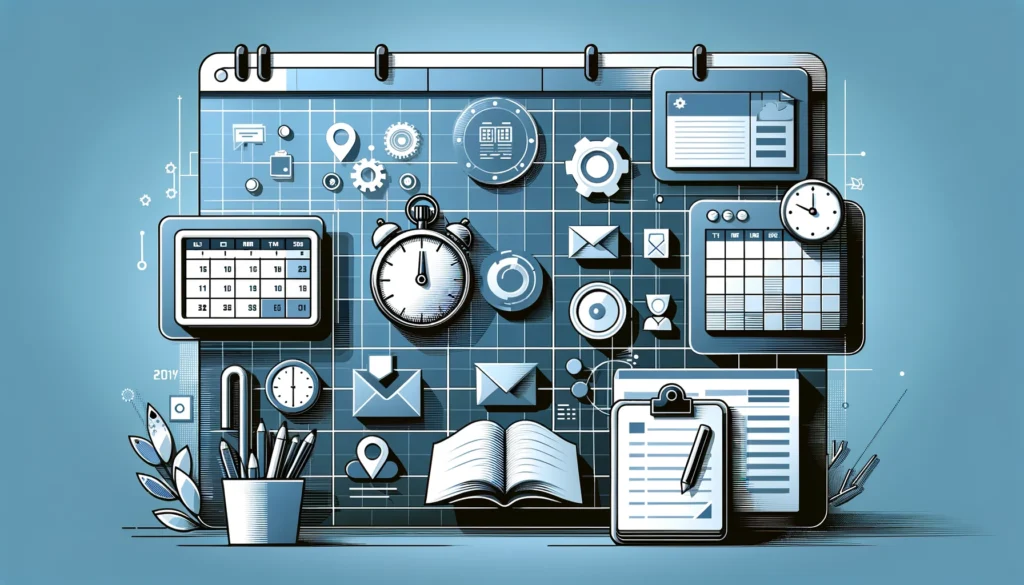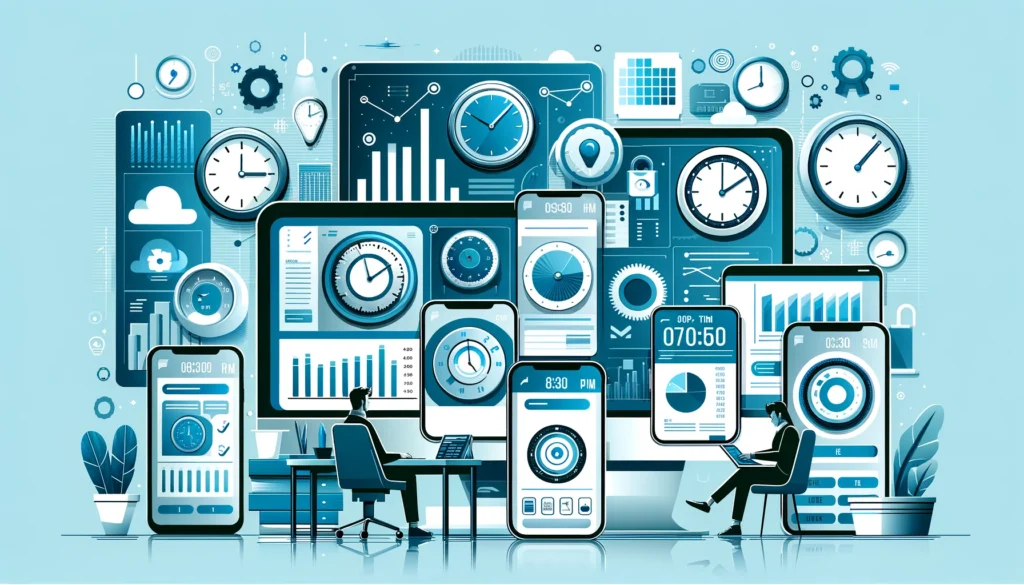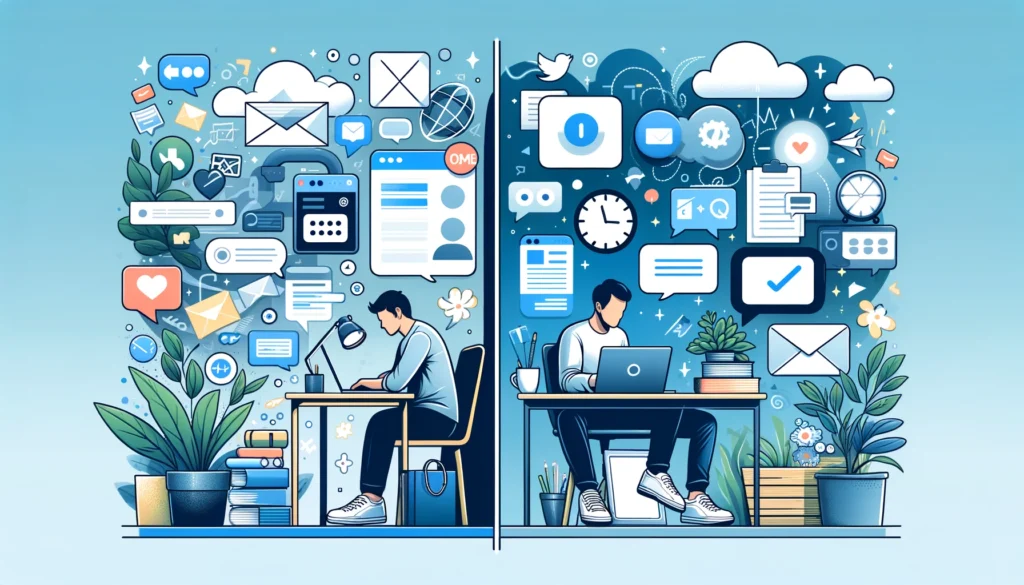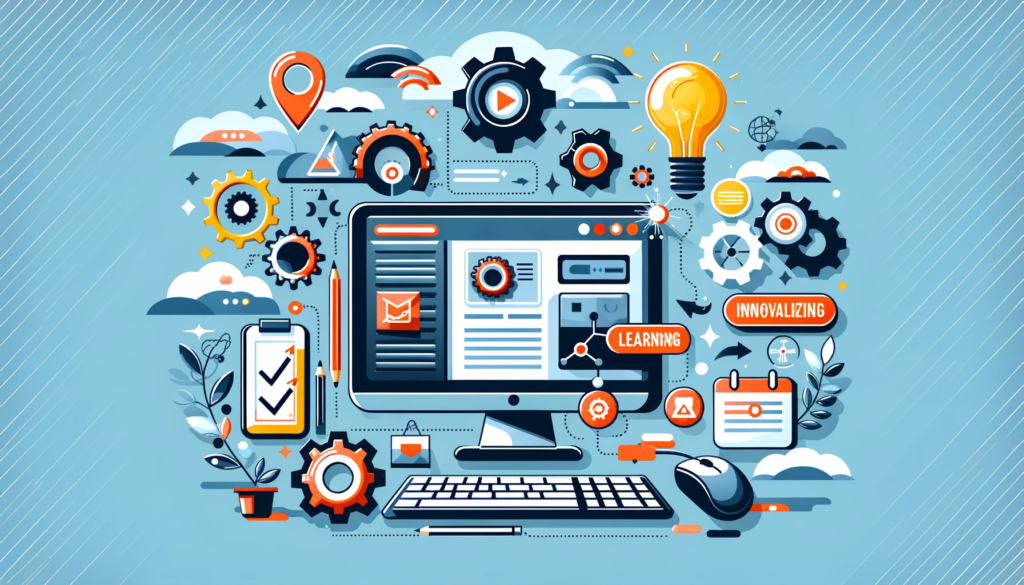
Leveraging Digital Tools
The advent of technology has given rise to an array of digital tools designed to enhance productivity and improve wellbeing. These tools, which range from productivity apps to time duration calculators, have revolutionized the way individuals manage their time and tasks.
Table of Contents
Enhancing Productivity
Digital tools for time management are designed to streamline work processes and enhance productivity. They offer a variety of features that enable users to manage tasks effectively, collaborate with team members, and stay on top of deadlines.
For instance, the collaboration features in productivity apps such as real-time editing, comment sections, and shared task boards simplify teamwork by transforming individual efforts into collective achievements, eliminating the need for endless email threads or meetings.
Scheduled reminders in productivity apps help users stay on top of commitments and deadlines by nudging them at predetermined times or when specific conditions are met, ensuring that no task slips through the cracks (Rode & Ankor).
Furthermore, productivity apps offer data analysis features that enable users to gain insights into their work habits, identify productive periods, areas of improvement, and set informed goals through tracking tasks completed, time spent, and analyzing patterns.
For more insights into how you can improve productivity with digital tools, check out our article on improving productivity with digital tools.
Improving Wellbeing
Beyond enhancing productivity, digital tools also play a crucial role in improving wellbeing. By helping individuals manage their time more effectively, these tools can reduce stress, increase satisfaction, and enhance overall wellbeing.
Through effective time management, individuals can achieve a better work-life balance, have more time for relaxation and hobbies, and reduce the risk of burnout. Digital tools can also help individuals stay on task and improve time management skills as evidenced by the advent of instant messaging via email compared to traditional postal services.
In conclusion, leveraging digital tools can significantly enhance productivity and improve wellbeing. Whether it’s through a productivity app, a time tracking software, or a project management tool, these digital solutions offer a practical and efficient approach to managing time and tasks. For more tips on leveraging technology for wellbeing, check out our article on leveraging technology for wellbeing.

Choosing Time Management Tools
Selecting the right digital tools for time management can have a significant impact on your productivity and wellbeing. However, with the multitude of options available, it can be overwhelming to decide which tools best suit your needs. In this section, we will delve into the factors to consider when choosing time management tools and explore the types of tools available.
Factors to Consider
When choosing time management tools, it’s important to consider several factors to ensure you select the best solution for your needs. These factors include:
- Preference for a single app or multiple apps
- Market leaders versus newcomers
- Software features
- User experience
- Mobile compatibility
In addition, consider how the tool fits into your daily routines and workflows. For instance, will the tool seamlessly integrate with your existing systems? Does it offer the flexibility to adapt to your changing needs? These questions can guide you in finding a tool that meets your specific requirements.
Types of Tools Available
There are various types of time management tools available, each offering unique features and benefits. Here are some types of tools you might consider:
- Calendar Apps: These tools are used for more than just scheduling meetings. They offer a “bird’s-eye view” of your time, helping you schedule tasks, set reminders, and manage your daily, weekly, or monthly agenda.
- Task/Project Management Apps: These apps help you manage, prioritize, and track the progress of various tasks or projects.
- Note-Taking Apps: These tools are versatile and can be used for brainstorming, writing guidelines, analyzing business issues, and preparing roadmaps. It’s beneficial for these apps to have templates and extensions/plugins for added functionality.
- Time Trackers: These are tools specifically designed to track the amount of time spent on different tasks. They are particularly useful for freelancers, remote workers, and teams looking to improve productivity with digital tools.
- Specialized Tools: These include apps for habit tracking and distraction prevention. They help you develop good habits, stay focused, and avoid time-wasting activities.
Remember, the best digital tools for time management are the ones that fit your personal workflow and help you achieve your desired outcomes. By carefully considering your needs and exploring the different types of tools available, you can find the perfect solution to supercharge your productivity and enhance your wellbeing.

Time Tracking Software
One of the most effective ways to boost productivity and manage time efficiently is by utilizing time tracking software. These digital tools provide individuals and businesses with the means to monitor and manage the amount of time spent on various ongoing tasks, projects, and activities (Stratoflow).
Benefits of Time Tracking
The use of time tracking software offers a multitude of benefits that significantly impact individual productivity, team collaboration, and overall project management. By recording and analyzing how time is allocated throughout the day, users can better understand their productivity patterns, identify areas for improvement, and make more informed decisions about resource allocation.
Key benefits of time tracking software include:
- Enhanced productivity
- Accurate billing for freelancers and businesses
- Improved project management and resource allocation
- Realistic time estimates for better planning
- Data-driven decision making
- Transparent client communication
- Remote work monitoring
- Task prioritization
- Personal time management
- Performance evaluation
- Compliance and regulations
- Automated processes
- Integration with other tools
Using time tracking software can also aid in improving efficiency with technology.
Top Time Tracking Solutions
A variety of time tracking software options exist, each with their unique features. Here are some top solutions:
- Clockify: Offers unlimited tracking for an unlimited number of projects. Features include summary reports, employee monitoring, offline mode, expense tracking, and customizable invoices (Source).
- QuickBooks Time: A cloud-based solution that allows employees to clock in and out from mobile apps and automatically transfer their data to timesheets. It also offers features such as PTO management, employee scheduling, and geotechnology for monitoring employee locations (Source).
- ClockShark: Designed specifically for small to midsize businesses in the construction and field service industries. Supports three clock-in methods, including mobile apps, kiosks, and facial recognition. It also includes features such as GPS tracking, drag-and-drop schedule editor, and JobFlow solution for managing active and inactive jobs (Source).
- Paymo: Focuses on time tracking, invoicing, and billing. Allows users to set live task timers, view detailed time reports, and create and send invoices directly from the software. Also offers features such as Kanban boards and Gantt charts for streamlining workflows and actionable insights for improving accountability.
Choosing the right time tracking software depends on the specific needs and requirements of the individual or business. By taking advantage of these digital tools for time management, one can significantly improve their productivity and enhance their overall wellbeing. To explore more ways to boost productivity with digital solutions, check out our article on improving productivity with digital tools.

Evolution to Digital Project Management
As the world continues to embrace digital technology, project management has undergone significant changes. The shift from traditional to digital project management has not only reshaped industries but also transformed the way projects are managed.
Contrasting Approaches
Traditional Project Management often emphasizes linear processes, hierarchical structures, and long-term planning, rooted in the industrial era. This approach, while effective in certain contexts, can be rigid and slow to adapt to change.
On the other hand, Digital Project Management aligns with the broader digital transformation in businesses. It reshapes industries with digital technologies and drives changes in project management practices, particularly over the past decade.
In contrast to the traditional model, Digital Project Management emphasizes flexibility, enabling projects to pivot quickly in response to changes like market shifts, customer feedback, or technological advancements. Project scopes are revisited and adjusted throughout the lifecycle, allowing for dynamic responses to evolving circumstances.
Advantages of Digital PM
One of the main advantages of Digital Project Management is its use of real-time and informal communication. Tools like Slack, Zoom, or Microsoft Teams facilitate faster decision-making and collaborative problem-solving. This real-time communication ensures that all team members are on the same page and can respond quickly to any changes or issues that may arise.
Additionally, Digital Project Management focuses on incremental deliveries with features released in stages. This approach allows for quicker user feedback, product refinement, and quicker adaptation to changes. Rather than waiting for a final product delivery, users can access and provide feedback on the project at different stages, enabling continuous improvement and refinement.
The shift to Digital Project Management aligns with the use of digital tools for time management, enhancing productivity and efficiency in the workplace. By leveraging technology, businesses can streamline their processes, improve communication, and adapt quicker to changing circumstances. With these advantages, it’s clear that digital solutions are a necessary tool for improving productivity and wellbeing in today’s rapidly evolving business landscape.

Impact of Technology on Time Management
As we delve deeper into the topic of using digital tools for time management, it is essential to acknowledge the impact that technology has on our perception of time and the challenges it presents in our daily lives.
Perceived Acceleration
Technology, particularly the advent of smartphones and high-speed internet, has been the driving force behind the acceleration of the pace of modern life. These advances have significantly reduced the time taken to complete tasks, creating a perceived rapidity in daily activities (Medium). This perceived acceleration can help individuals feel more productive and efficient, contributing to the overall benefits of leveraging digital solutions for productivity.
Emerging technologies like augmented reality (AR), virtual reality (VR), Internet of Things (IoT), artificial intelligence (AI), and automation are set to reshape time management further. AI analyzes data to aid time allocation decisions, and automation streamlines tasks, freeing up time for more complex activities. However, these advances also raise questions about work-life boundaries, adding another layer of complexity to time management (Medium).
Challenges and Distractions
While technology can enhance time management, it also presents challenges. Social media and continuous notifications are notable sources of interruptions and diversions affecting focus and attention. Notifications lead to a continuous stream of interruptions, diverting users from tasks at hand (Medium).
Multitasking, once considered a desirable skill, is now viewed critically due to the cognitive overload caused by juggling multiple tasks. This overload can compromise attention quality and decision-making effectiveness. Moreover, decision fatigue, defined as a decline in decision quality after making numerous choices, is exacerbated in the digital context due to the continuous need for decision-making in responding to emails and selecting digital options. This fatigue impacts effective time management and sound judgment.
To counter these challenges, it’s essential to employ strategies such as setting specific times for checking notifications, using tools to limit social media use, and taking regular breaks to recharge and refocus. By using technology mindfully, individuals can improve productivity while also leveraging technology for wellbeing.

Productivity Apps
Productivity apps are becoming increasingly popular as more people seek digital tools for time management to improve their efficiency and wellbeing. These apps provide a range of features aimed at enhancing productivity and facilitating collaboration.
Features and Benefits
Productivity apps offer numerous features designed to streamline workflows and enhance efficiency. Synchronization is a key feature, ensuring that users have access to the most recent version of their tasks, notes, and progress across different devices. This makes data consistent and updated, allowing users to effectively manage their tasks from anywhere and at any time.
Another key feature of productivity apps is scheduled reminders. These help users stay on top of commitments and deadlines by nudging them at predetermined times or when specific conditions are met. This ensures that no tasks slip through the cracks, boosting productivity.
Finally, productivity apps often offer data analysis features that enable users to gain insights into their work habits. By tracking tasks completed, time spent, and analyzing patterns, users can identify productive periods, areas for improvement, and set informed goals. This data-driven approach enables users to maximize their efficiency and productivity (Rode & Ankor).
Enhancing Collaboration
Beyond individual productivity, these apps also have features aimed at enhancing collaboration. Real-time editing, comment sections, and shared task boards transform individual efforts into collective achievements. These features simplify teamwork by eliminating the need for endless email threads or meetings, promoting efficient communication and collaboration.
By leveraging productivity apps, individuals and teams can overcome the challenges of time management, improve their efficiency, and enhance their wellbeing. While traditional methods offer a tactile experience that can reinforce memory retention and understanding, the convenience, versatility, and data-driven insights provided by digital solutions offer compelling advantages. Explore more on the topic of leveraging technology for wellbeing and improving efficiency with technology to learn how digital tools can supercharge productivity and wellbeing.

